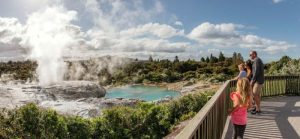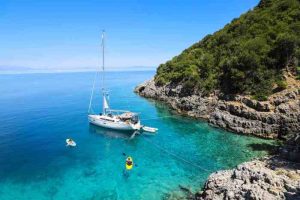
Embark on a captivating journey into the heart of the Arctic, where breathtaking landscapes meet incredible wildlife. Arctic wildlife expeditions offer an unparalleled opportunity to witness the raw beauty of the polar regions and encounter iconic creatures like polar bears, walruses, and whales in their natural habitat. This guide delves into the planning, execution, and ethical considerations of such expeditions, ensuring a responsible and rewarding experience for adventurous travelers.
From choosing the right operator and understanding the varying costs and durations to mastering wildlife photography and crafting compelling narratives, we cover all aspects of planning an Arctic wildlife expedition. We also explore the environmental impact of these trips and emphasize the importance of sustainable tourism practices to preserve this fragile ecosystem for future generations.
Arctic Wildlife Expedition Overview

Arctic wildlife expeditions offer unparalleled opportunities to witness the breathtaking beauty and unique biodiversity of the Arctic regions. These journeys range from comfortable cruises aboard ice-strengthened vessels to more adventurous expeditions involving kayaking, hiking, and camping in remote locations. Choosing the right expedition depends on your budget, desired level of comfort, and specific wildlife viewing interests.
Types of Arctic Wildlife Expeditions
Several types of Arctic wildlife expeditions cater to diverse preferences. Luxury cruises provide comfortable accommodations and gourmet dining while offering ample opportunities for wildlife viewing from the ship’s deck and via guided excursions. More adventurous expeditions focus on active exploration, incorporating activities like kayaking amongst icebergs, hiking across tundra landscapes, and camping under the Arctic sky. Specialized expeditions might focus on specific wildlife, such as polar bears, whales, or seabirds, offering expert-led tours designed to maximize sighting opportunities.
Some expeditions even include opportunities for photography workshops or scientific research participation.
Typical Itinerary of a Week-Long Arctic Wildlife Expedition
A typical week-long Arctic wildlife expedition might follow a structured itinerary, but flexibility is often built in to account for weather conditions and wildlife sightings. A sample itinerary could include: Day 1: Arrival and embarkation; Days 2-6: Daily excursions for wildlife viewing (e.g., boat trips, hikes), presentations by naturalists or experts; Day 7: Disembarkation and departure. Specific activities would vary depending on the location and the operator, with some days dedicated to exploring specific areas known for particular wildlife.
For example, one day might be focused on whale watching, while another might involve a visit to a bird sanctuary or a polar bear viewing area (always with appropriate safety measures).
Comparison of Expedition Operators and Offerings
Numerous operators offer Arctic wildlife expeditions, each with its own unique approach and focus. Some prioritize luxury and comfort, offering spacious cabins, fine dining, and a high level of personalized service. Others emphasize adventure and exploration, offering more physically demanding activities and a closer connection with the Arctic wilderness. Some operators specialize in specific wildlife or geographic regions, offering expert-led tours tailored to particular interests.
The choice of operator depends on individual preferences and priorities, considering factors like the level of comfort, the type of activities offered, and the overall cost. Reputable operators will adhere to strict environmental guidelines and prioritize the safety and well-being of both passengers and the Arctic environment.
Comparison of Expedition Costs, Durations, and Included Activities
The following table provides a simplified comparison of potential expedition options. Note that actual costs and inclusions can vary significantly depending on the specific operator, time of year, and availability. These are examples only and should not be considered definitive pricing.
| Expedition Operator | Duration (Days) | Approximate Cost (USD) | Included Activities |
|---|---|---|---|
| Example Operator A (Luxury) | 7 | 15,000 | All meals, comfortable cabin, guided wildlife viewing excursions (boat trips, Zodiac cruises), lectures by experts |
| Example Operator B (Adventure) | 10 | 8,000 | Camping, kayaking, hiking, basic meals, guided wildlife viewing excursions (hiking, kayaking), some equipment rental |
| Example Operator C (Specialized – Polar Bears) | 8 | 12,000 | All meals, comfortable cabin, guided excursions focused on polar bear viewing (by boat and potentially land-based), expert-led presentations |
Wildlife Encounters
Embarking on an Arctic expedition offers unparalleled opportunities to witness some of the planet’s most magnificent and elusive creatures in their natural habitat. The raw beauty of the Arctic landscape is complemented by the incredible wildlife that calls it home, creating an unforgettable experience for any adventurer. From majestic polar bears to playful walruses, the diversity of Arctic fauna is truly breathtaking.The Arctic’s wildlife varies significantly depending on the time of year and specific location.
Understanding these seasonal changes is crucial for maximizing your chances of observing specific animals and ensuring a responsible and ethical viewing experience. This section will detail the potential wildlife sightings, optimal viewing times, and ethical considerations for wildlife viewing in this unique and fragile ecosystem.
Potential Wildlife Sightings
The Arctic boasts a remarkable array of wildlife. Polar bears, the undisputed kings of the Arctic, are a prime attraction. Their powerful presence and impressive hunting skills are a sight to behold. Walruses, with their distinctive tusks and blubbery bodies, often haul out on ice floes or beaches in large groups. Various whale species, including bowhead whales, beluga whales, and narwhals, migrate through Arctic waters, offering spectacular displays of their aquatic grace.
Other notable sightings include Arctic foxes, seals (such as ringed seals and harp seals), various seabirds (like puffins and fulmars), and even reindeer or caribou in certain regions. The specific species encountered will depend greatly on the expedition’s location and time of year.
Optimal Viewing Times for Specific Arctic Animals
Timing your expedition strategically increases the likelihood of witnessing specific wildlife. For example, the best time to see polar bears is during the late spring and summer months (May-August) when they are more active on land, particularly around areas where they hunt seals. Walruses are commonly sighted throughout the summer months, congregating on ice floes and beaches. Whale watching opportunities are often best in the summer months when whales migrate through the Arctic waters to feed.
Different species have varying migration patterns, so researching the specific area of your expedition will help refine the optimal viewing period.
Ethical Considerations for Wildlife Viewing
Responsible wildlife viewing is paramount in the Arctic. Maintaining a safe distance from animals is crucial to avoid disturbing their natural behavior and ensuring both your safety and the animals’ well-being. Never approach or attempt to feed wildlife. Use binoculars and spotting scopes to observe animals from afar, minimizing your impact on their environment. Follow the guidelines and instructions provided by your expedition guides, who are trained to ensure ethical and safe wildlife viewing practices.
Remember, you are a visitor in their home, and your actions should reflect respect for the Arctic ecosystem and its inhabitants.
Safe Wildlife Viewing Practices
An infographic detailing safe wildlife viewing practices would visually represent the following key points:
Image Description: A graphic with a central image of a person observing wildlife from a safe distance through binoculars. Surrounding this are smaller icons and text explaining different aspects of safe viewing practices.
Icon 1: Binoculars and Spotting Scope. Text: Use optical equipment for observation from a distance. Avoid getting too close to animals.
Icon 2: A large footprint with a red ‘X’ through it. Text: Minimize your impact. Avoid disturbing animal habitats or trails.
Icon 3: A person pointing to a group of animals in the distance, with an arrow indicating a large safe distance. Text: Maintain a safe distance. Never approach or chase animals. Observe their natural behaviour.
Icon 4: A hand holding food with a red ‘X’ through it. Text: Do not feed wildlife. Feeding alters natural behaviours and can be dangerous.
Icon 5: A person listening attentively. Text: Listen to your guides. They are trained to ensure your safety and the animals’ well-being.
Icon 6: A camera with a lens pointing to a distant animal. Text: Capture memories responsibly. Respect wildlife and avoid using flash photography.
Icon 7: A person wearing appropriate clothing. Text: Dress appropriately. Wear layers to adapt to changing weather conditions.
Icon 8: A map highlighting a safe viewing area. Text: Stay in designated areas. Follow the instructions of your expedition leaders.
Environmental Impact and Sustainability
Arctic wildlife expeditions, while offering incredible opportunities for exploration and wildlife viewing, inevitably leave an environmental footprint. The delicate balance of the Arctic ecosystem is particularly vulnerable to human activity, making responsible tourism crucial for its preservation. Understanding the potential impacts and adopting sustainable practices is paramount to ensuring future generations can also experience the wonders of this unique environment.The environmental impact of Arctic expeditions stems from several sources.
Ship emissions contribute to air pollution and greenhouse gas emissions, exacerbating climate change, which is already significantly affecting the Arctic. Waste disposal, even with careful management, poses a risk to wildlife and the pristine landscape. Disturbance of wildlife, whether through noise pollution from vessels or close proximity to animals, can disrupt their natural behaviours and breeding patterns.
Furthermore, the introduction of invasive species through equipment or human contact presents a considerable threat to the region’s biodiversity.
Sustainable Tourism Practices in the Arctic
Several initiatives and practices are actively promoting sustainable tourism in the Arctic. Many expedition operators now prioritize fuel-efficient vessels and invest in cleaner technologies to minimize emissions. Waste management systems onboard ships are becoming increasingly sophisticated, with a focus on reducing, reusing, and responsibly recycling waste. Operators are also adopting stricter guidelines regarding wildlife viewing, maintaining respectful distances and minimizing disturbance.
The emphasis is shifting towards smaller group sizes and more immersive, low-impact experiences, rather than large-scale tourist operations. For instance, some companies are using electric or hybrid-powered boats for quieter and cleaner travel within fjords and closer to wildlife. Additionally, initiatives are underway to educate both tourists and local communities on responsible travel practices, fostering a sense of shared responsibility for environmental protection.
The Role of Responsible Travel in Preserving the Arctic Ecosystem
Responsible travel is not merely a set of guidelines; it’s a fundamental principle for preserving the Arctic’s unique ecosystem. By choosing operators committed to sustainability, tourists directly support environmentally conscious practices. Respecting wildlife and their habitats is crucial. This includes adhering to guidelines set by operators and local authorities, maintaining a safe distance from animals, and refraining from any actions that could disrupt their natural behaviour.
Reducing personal waste generation through mindful consumption and proper disposal is equally important. Supporting local communities and businesses through responsible spending helps to ensure that tourism benefits the region sustainably, rather than contributing to exploitation. Ultimately, responsible travel in the Arctic means actively minimizing one’s impact while maximizing the positive contributions to the environment and local communities.
Tips for Minimizing Environmental Impact During an Arctic Expedition
Careful planning and mindful behaviour can significantly reduce the environmental impact of an Arctic expedition. Here are some key tips:
- Choose an expedition operator with a strong commitment to sustainability and responsible tourism practices. Look for certifications and evidence of their environmental initiatives.
- Pack light to reduce the weight and fuel consumption of the expedition vessel.
- Minimize waste generation by bringing reusable water bottles, food containers, and bags.
- Properly dispose of all waste according to the operator’s guidelines. Never litter.
- Respect wildlife by maintaining a safe distance and refraining from disturbing their natural behaviour. Follow the instructions of your guides.
- Avoid purchasing souvenirs made from endangered species or materials that harm the environment.
- Educate yourself about the Arctic ecosystem and the potential impacts of tourism before your trip.
- Support local communities and businesses through responsible spending.
Logistics and Preparation
Embarking on an Arctic wildlife expedition requires meticulous planning and preparation to ensure a safe and enjoyable experience. This section details the essential logistical aspects, from packing the right gear to understanding necessary health and safety precautions. Careful preparation minimizes potential risks and maximizes the chances of a successful and memorable trip.
Necessary Clothing and Equipment
Appropriate clothing and equipment are paramount for surviving and thriving in the Arctic’s harsh conditions. Extreme cold, strong winds, and potential precipitation demand layers of high-quality, insulating garments. This equipment protects against hypothermia and frostbite, ensuring comfort and safety throughout the expedition.
- Base Layers: Thermal underwear made of merino wool or synthetic materials to wick away moisture.
- Mid Layers: Fleece jackets or sweaters for insulation.
- Outer Layers: A waterproof and windproof parka and pants, ideally designed for extreme cold.
- Headwear: A warm hat that covers the ears, and a balaclava for added protection in extreme cold.
- Footwear: Insulated, waterproof boots rated for sub-zero temperatures, with thick, warm socks.
- Gloves/Mittens: Multiple pairs, including liner gloves and insulated mittens or gloves.
- Accessories: A scarf or neck gaiter, sunglasses or goggles (with UV protection), and sunscreen.
- Backpack: A durable, waterproof backpack to carry personal belongings and daily essentials.
- Binoculars: High-quality binoculars for wildlife viewing.
- Camera: A camera with a good zoom lens to capture stunning Arctic scenery and wildlife.
Health and Safety Considerations
Prioritizing health and safety is crucial for any Arctic expedition. Travelers should consult their physician well in advance to discuss necessary vaccinations, potential health risks, and any pre-existing conditions that might be exacerbated by the extreme environment. Understanding and preparing for potential emergencies is equally important.
- Consult a physician: Discuss necessary vaccinations, medications, and potential health concerns.
- Travel insurance: Comprehensive travel insurance covering medical emergencies, evacuation, and trip cancellations is essential.
- First-aid kit: Pack a well-stocked first-aid kit including items specifically for cold-weather injuries.
- Personal medications: Bring a sufficient supply of any prescription medications.
- Seasickness medication (if applicable): If traveling by boat, consider seasickness medication.
- Emergency communication: Familiarize yourself with emergency communication procedures and protocols.
Planning and Booking an Arctic Wildlife Expedition
Planning and booking an Arctic expedition involves several steps, from choosing a reputable tour operator to securing necessary permits and travel arrangements. Careful research and timely booking are vital to ensure a smooth and successful trip.
- Research and choose a tour operator: Select a reputable tour operator with experience in Arctic expeditions, focusing on their safety record and sustainability practices.
- Determine your budget: Arctic expeditions can be expensive, so establishing a realistic budget is crucial.
- Choose your destination and time of year: Consider factors like wildlife viewing opportunities, weather conditions, and accessibility when selecting your destination and travel dates.
- Book flights and accommodation: Secure flights and accommodation well in advance, especially during peak season.
- Review the itinerary and required documentation: Carefully review the expedition itinerary and ensure you have all the necessary documentation, such as passports and visas.
- Pack your gear: Pack your clothing and equipment according to the provided packing list (see below).
- Prepare for potential delays or changes: Be prepared for potential delays or changes in the itinerary due to weather conditions or other unforeseen circumstances.
Essential Packing Checklist
A comprehensive packing list is essential to ensure you have all the necessary items for a successful Arctic expedition. This list provides a framework, and specific items may vary depending on the expedition’s duration and activities.
- Passport and visa (if required)
- Travel insurance documents
- Flight and accommodation confirmations
- Copies of important documents (stored separately)
- Sufficient cash and credit cards
- Prescription medications (with a copy of the prescription)
- First-aid kit
- Sunscreen and lip balm with SPF
- Headlamp or flashlight with extra batteries
- Reusable water bottle
- Toiletries
- Camera and extra batteries
- Binoculars
- Journal and pen
- Books or other entertainment
Comparison with Other Adventure Travel Types
Arctic wildlife expeditions offer a unique blend of adventure, wildlife observation, and cultural immersion, setting them apart from other travel styles. While some share elements, the focus on Arctic wildlife and its fragile ecosystem distinguishes this type of expedition. The following comparisons highlight these key differences.
Arctic Wildlife Expeditions Compared to Adventure Sports Travel
Adventure sports travel emphasizes physical challenges and adrenaline-inducing activities, such as mountaineering, white-water rafting, or extreme skiing. Arctic wildlife expeditions, while potentially involving some physical exertion (e.g., hiking to viewing points), prioritize wildlife observation and learning about the Arctic environment. The focus is less on personal athletic achievement and more on appreciating the natural world. For instance, an adventure sports trip might involve a challenging climb up a mountain, whereas an Arctic wildlife expedition might involve a gentler hike to observe a walrus colony.
Arctic Wildlife Expeditions Compared to Birdwatching Tours
While birdwatching tours focus specifically on avian species, Arctic wildlife expeditions encompass a broader range of wildlife, including mammals (polar bears, whales, seals), birds, and potentially even invertebrates. Birdwatching tours may be more location-specific, targeting areas known for particular bird species, whereas Arctic wildlife expeditions explore a wider range of habitats within the Arctic region, encountering a greater diversity of species.
A birdwatching tour might focus on identifying different species of migratory birds, while an Arctic expedition would encompass this but also include observing polar bears and seals in their natural environment.
Arctic Wildlife Expeditions Compared to Arctic and Polar Expeditions
All Arctic and polar expeditions explore the high-latitude regions, but Arctic wildlife expeditions specifically emphasize wildlife encounters. Other Arctic and polar expeditions may focus on scientific research, exploration, or historical sites. For example, a scientific expedition might focus on collecting ice core samples, while a wildlife expedition prioritizes observing and photographing polar bears and other animals. The unique aspect of wildlife-focused trips lies in the dedicated effort to provide opportunities for close (but responsible) wildlife observation, guided by experts.
Arctic Wildlife Expeditions Compared to Other Travel Types
| Travel Type | Similarities to Arctic Wildlife Expeditions | Differences from Arctic Wildlife Expeditions | Example |
|---|---|---|---|
| Golf Vacations | Both involve travel to specific locations, often with planned itineraries. | Arctic wildlife expeditions focus on wildlife observation and environmental education, while golf vacations center on golfing and resort amenities. | A luxurious golf resort in Scotland versus a remote Arctic research station. |
| Sailing and Yachting | Both offer opportunities for exploration and experiencing unique environments. | Arctic wildlife expeditions prioritize wildlife viewing and learning, whereas sailing and yachting may focus on the journey itself and nautical skills. | A transatlantic yacht race versus a boat-based expedition to observe whales in the Arctic. |
| Jungle and Rainforest Exploration | Both involve exploring remote natural environments and observing diverse wildlife. | Arctic wildlife expeditions occur in a unique, cold climate with specific Arctic species, whereas jungle and rainforest explorations take place in tropical climates with different flora and fauna. | Exploring the Amazon rainforest versus exploring the Arctic tundra. |
| Wellness Cruises | Both involve travel and planned activities. | Arctic wildlife expeditions focus on wildlife and the Arctic environment, while wellness cruises prioritize relaxation, fitness, and health treatments. | A spa cruise in the Caribbean versus an expedition to observe polar bears. |
| Geological Destinations | Both involve visiting locations with unique geological features. | Arctic wildlife expeditions prioritize wildlife viewing, while geological destinations focus on geological formations and processes. | Visiting the Grand Canyon versus exploring the Arctic’s unique geological formations alongside wildlife viewing. |
| Music and Performing Arts Travel | Both involve travel and planned events. | Arctic wildlife expeditions focus on wildlife and the natural environment, while music and performing arts travel focuses on attending concerts or performances. | Attending a music festival versus an Arctic wildlife expedition focused on observing wildlife. |
| Educational Tours | Both involve learning and gaining knowledge. | Arctic wildlife expeditions focus on environmental education and wildlife observation, while educational tours may cover a broader range of subjects and locations. | A history tour of Europe versus an educational Arctic expedition focusing on climate change and wildlife adaptation. |
Epilogue

Planning an Arctic wildlife expedition is an investment in an unforgettable adventure. By understanding the logistical aspects, prioritizing ethical wildlife viewing, and minimizing your environmental impact, you can contribute to the preservation of this remarkable region while creating memories that will last a lifetime. Remember to carefully research operators, prepare adequately, and embrace the opportunity to connect with the pristine beauty and unique wildlife of the Arctic.
The experience will undoubtedly enrich your understanding of the natural world and inspire a deeper appreciation for its conservation.
Q&A
What is the best time of year to go on an Arctic wildlife expedition?
The ideal time depends on the specific wildlife you wish to see. Generally, summer (June-August) offers the best opportunities for wildlife viewing due to longer daylight hours and increased animal activity. However, winter (December-February) offers unique experiences, like viewing the Northern Lights.
How much does an Arctic wildlife expedition cost?
Costs vary significantly depending on the duration, operator, level of luxury, and included activities. Expect to pay anywhere from several thousand to tens of thousands of dollars.
What kind of physical fitness is required?
While varying by expedition, a reasonable level of fitness is generally recommended. Many expeditions involve moderate walking and potentially some light hiking. Consult with your chosen operator for specific fitness requirements.
Are Arctic wildlife expeditions safe?
Reputable operators prioritize safety and provide experienced guides. However, the Arctic environment presents inherent risks, and participants should be aware of potential hazards and follow safety guidelines provided by the operator.





